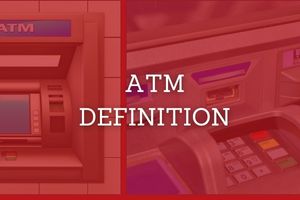What is ATM mean?
ATM, short for automated teller machine, is a dedicated computer that helps bank account holders manage their money. It allows you to check account balances, withdraw or deposit money, print statements of account activity and transactions, and even buy stamps.
ATMs were first used in London in 1967 and were used nationwide 50 years later.
ATMs are onsite or offsite. Local ATMs are located at financial institutions. Customers enjoy more choice, convenience, and availability, while banks increase transaction revenues, reduce operating costs and maximize human resources.

Off-premises ATMs are usually located in places where cash is needed, such as airports, grocery stores, convenience stores, and shopping malls. ATM is a simple data terminal with four output devices and two input devices. They must connect and communicate through the host processor. The host processor acts like an Internet Service Provider (ISP). An Internet Service Provider (ISP) is a portal that allows a bank account holder to access all the various networks of ATMs using a credit card or debit card.
Table of Contents
ATM examples
Account holders can use ATMs to complete a variety of transactions.
The most common transaction done by ATM cardholders in the ATM is Withdrawals. This permits them to withdraw the amount from their account. To make a withdrawal, account holders simply enter the amount they wish to withdraw.
ATM deposits are also becoming increasingly popular. Account holders of a particular bank can deposit cash into their account linked to that particular bank and check if their bank allows it.
Balance inquiry allows account holders to check their current account balance. This feature is useful when account holders need to know how much money they can spend on their debit or credit card.
Depending on the bank, it is also possible to make a transfer or deposit. This allows account holders to transfer funds from one account to another without withdrawing cash. Account holders who use non-bank-affiliated ATMs are almost always required to pay a fee. ATMs always display these fees on the screen and give users the option to cancel the transaction if they do not want to pay the fees.
In the US, the average fee for a single ATM withdrawal is approximately $4.52. This fee usually varies by state. Atlanta typically has the highest average ATM fees at around $5.15, while Seattle has the lowest average ATM fees at $4.21. Users should be aware of threats targeting these computers. For security reasons, users are required to make transactions at ATMs in well-lit public areas.
Summary
In simple words, ATM means automated teller machine which is an electronic banking facility that allows customers to complete basic transactions without the assistance of a branch representative or teller. Anyone with a credit or debit card can access cash at most ATMs in the United States and abroad.
ATMs are convenient and allow consumers to quickly perform self-service transactions such as making deposits, withdrawing cash, paying bills, and transferring funds between accounts. Fees are typically charged for cash withdrawals by the bank where the account is held, the ATM operator, or both. Some or all of these fees can be avoided by using ATMs operated directly by the bank where you hold your account. Using an ATM abroad may be more expensive than using it in the United States.
FAQs: Frequently Asked Questions
What is ATM full form?
ATM stands for Automated Teller Machine.
Why ATM is called Automated Teller Machine?
A cash machine is an electronic device used for financial transactions. As the term suggests, this is an “automated” banking platform that does not require bank agents or tellers, or human tellers.
What is ATM card?
A bank card which is used to access an ATM. Most people who have a checking account also have a card that can be used at ATMs, in the form of a debit or credit card. However, some banks also issue ATM-only cards that cannot be used directly for purchases.
What is ATM Pin?
An ATM PIN is a four-digit number required to complete transactions at an automated teller machine (ATM). This PIN is initially assigned by the bank, which is supposed to change by the user for safety. ATM PIN can be changed and regenerated as many times as you like at any time.
What is ATM Card Number?
The 16 digits printed on the card is the debit card number. This is unique to your checking account, but is different from your account number. This 16-digit card number is required while making online transactions.
Who is the real inventor of ATM?
John Adrian Shepherd Baron (23 June 1925 – 15 May 2010) was an Indian-born British inventor who invented the first automated teller machine (the cash machine or the automated teller machine).
Which bank started to use ATM first in the world?
Barclays



